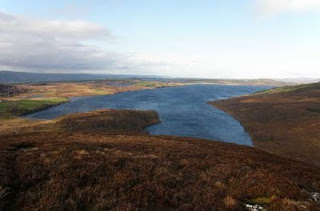In my previous blog about the angler on Loch Ness, it was pointed out to me that there was a water bull story just before it! Unfortunately, the loch is not stated as being Loch Ness but a body of water four miles by two. An inspection of an ordnance survey map may reveal some likely candidates but here is the story:
"In Inverness-shire there are many lovely lakes, and many an hour and day have I passed in fishing on some of these. There was one beautiful lake to which I used sometimes to take net and boat, as well as rod. It was a piece of water about four miles long, and one or two broad ; at one end were two sandy bays, forming regular semicircles, with their beaches covered to a width of a few feet with small pebbles. Between these two bays was a bold rocky promontory running into the lake, and covered with fine old pine trees. Along one side was a stretch of perhaps three miles of grey precipitous rocks nearly covered with birch and hazel, which hung over the water, casting a dark shade on it. The other end of the lake was contracted between the rocks till it was lost to the view, while on the remaining side was flat moorland.
Indeed, the hill side which sloped down to the lake had the name of being haunted, and the waters of the lake itself had their ghostly inhabitant in the shape of what the Highlanders called the water-bull. There was also a story of some strange mermaid-like monster being sometimes seen, having the appearance of a monstrous fish with long hair."
After a bit of grubbing around various maps, I think the most likely candidate for the loch is Loch Duntelchaig which is the biggest "satellite" loch around Loch Ness and lies about 3 miles south east of Dores. It seems it once (or still does) form some of the water supply to Inverness. On an older map the loch is named "Loch Dun Seilcheig". Curiously, "seilcheig" is the gaelic genitive singular form of "seilcheag" which means "snail" or "slug". So this loch would appear to be the "loch of the fort of the slug". There are the remains of an Iron Age fort nearby but we wonder what the word "slug" connates. Ted Holiday and other Nessie invertebrate theory fans would be pleased ....
